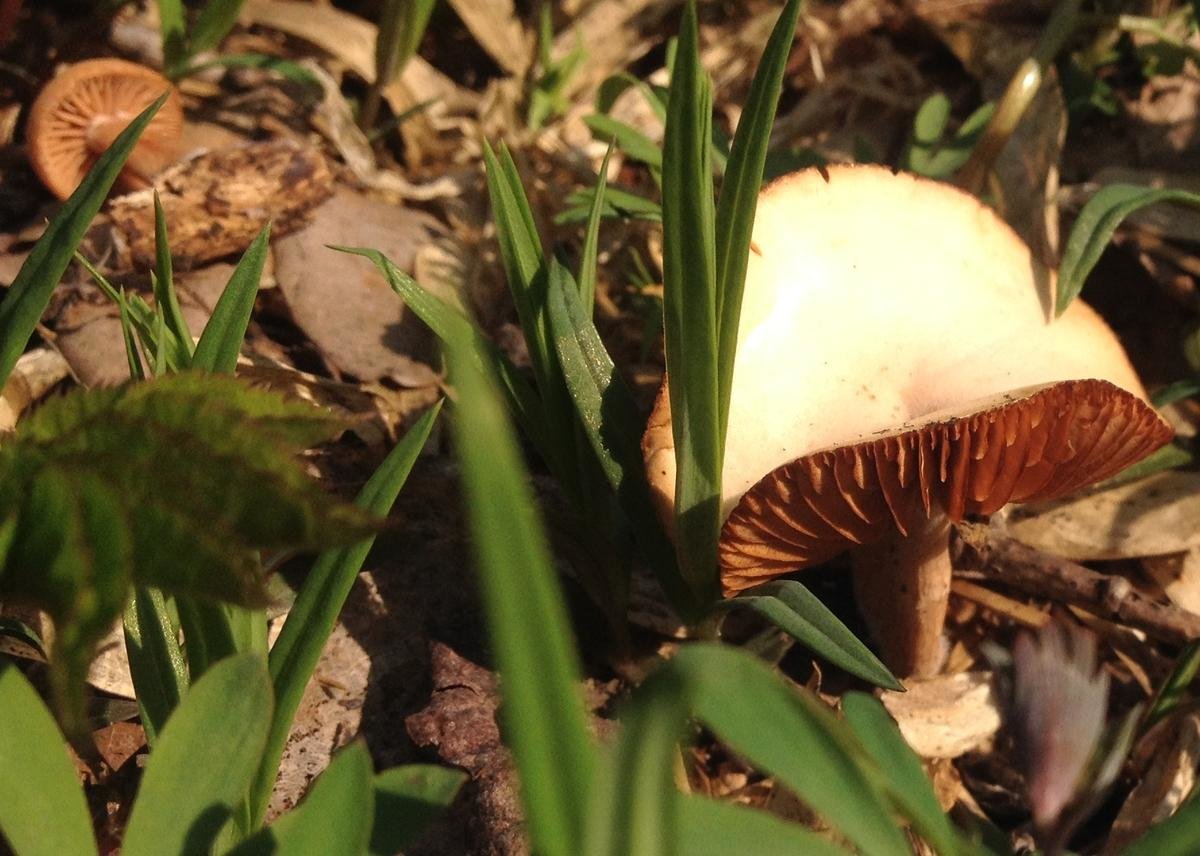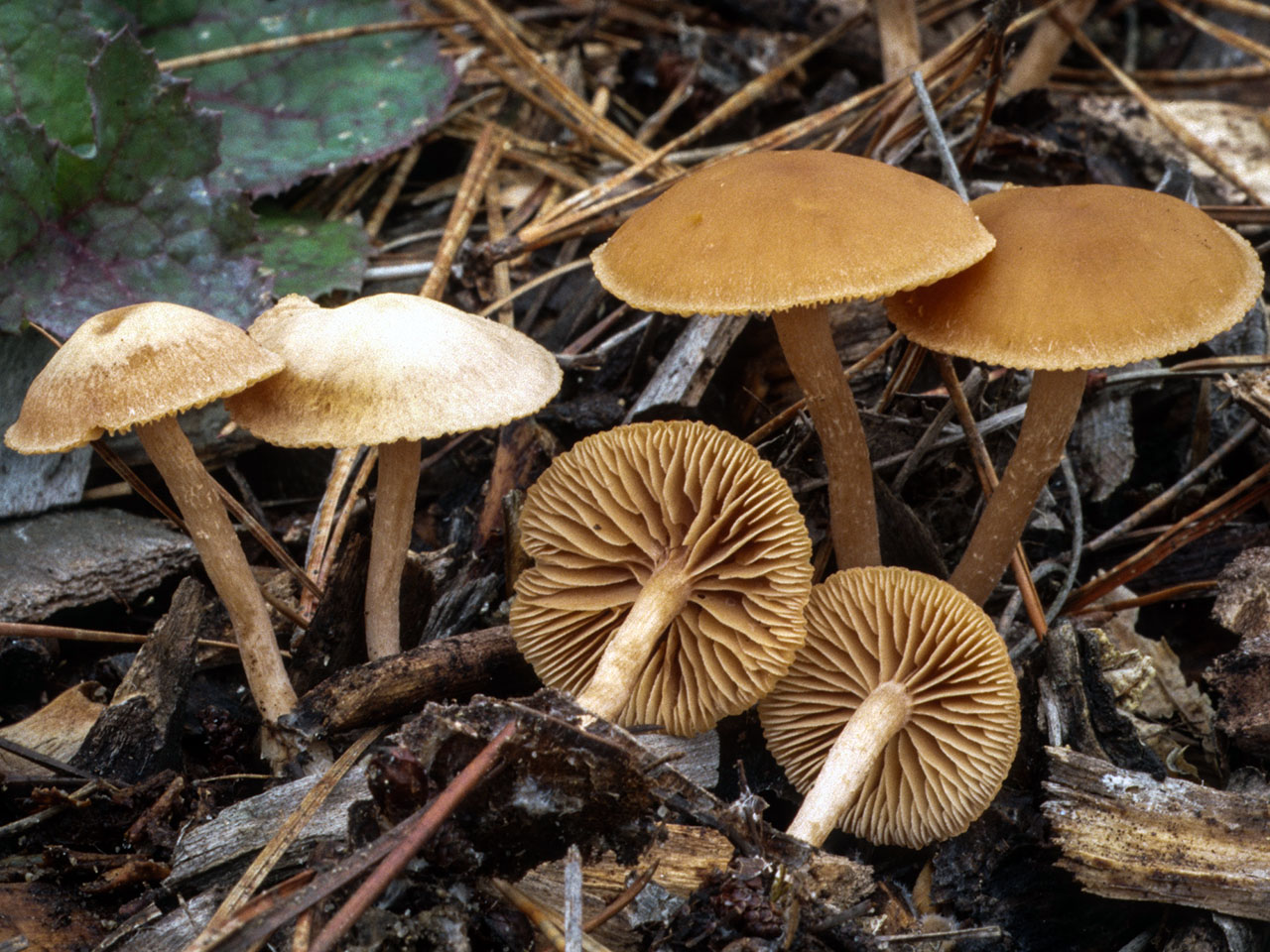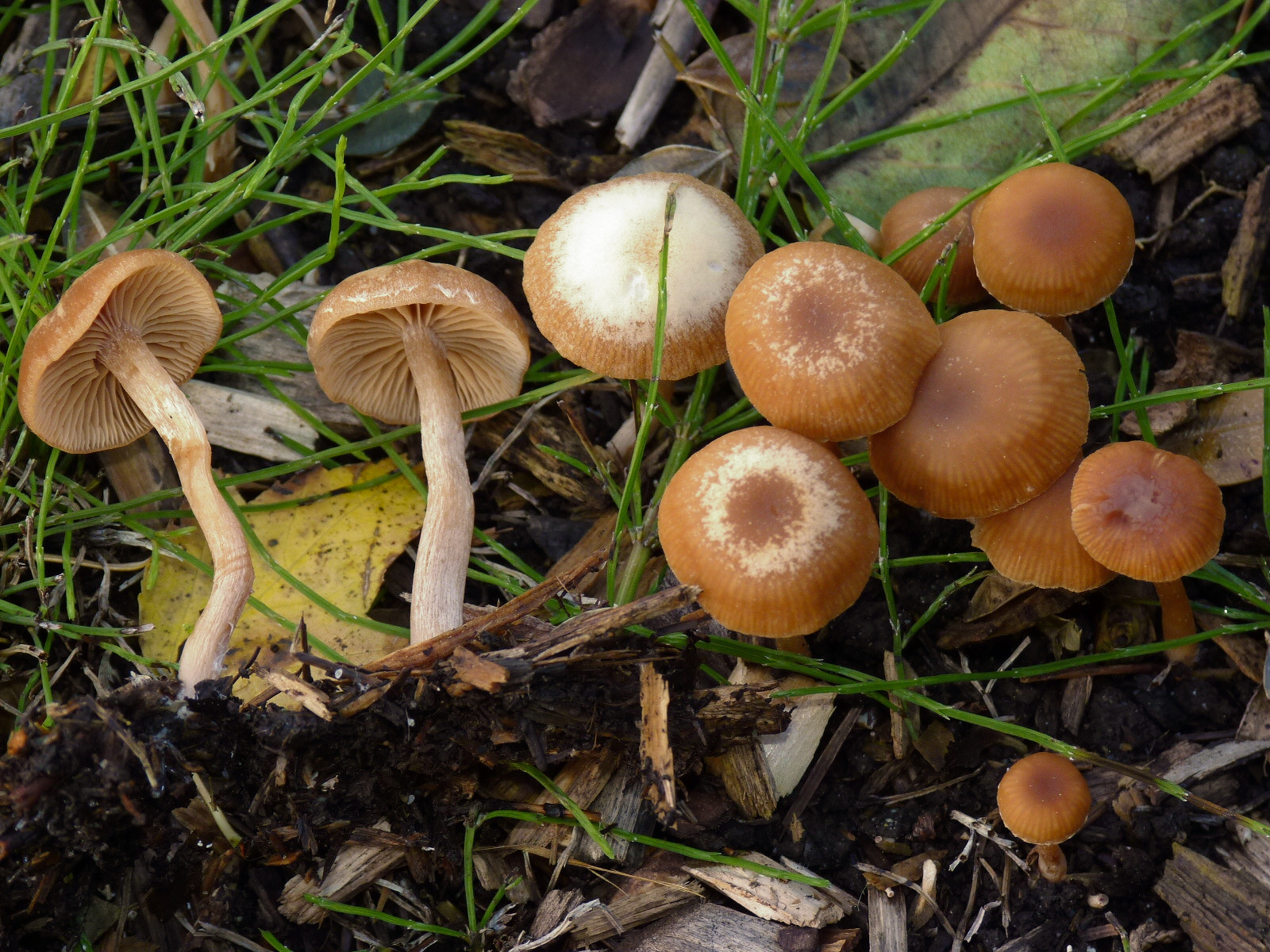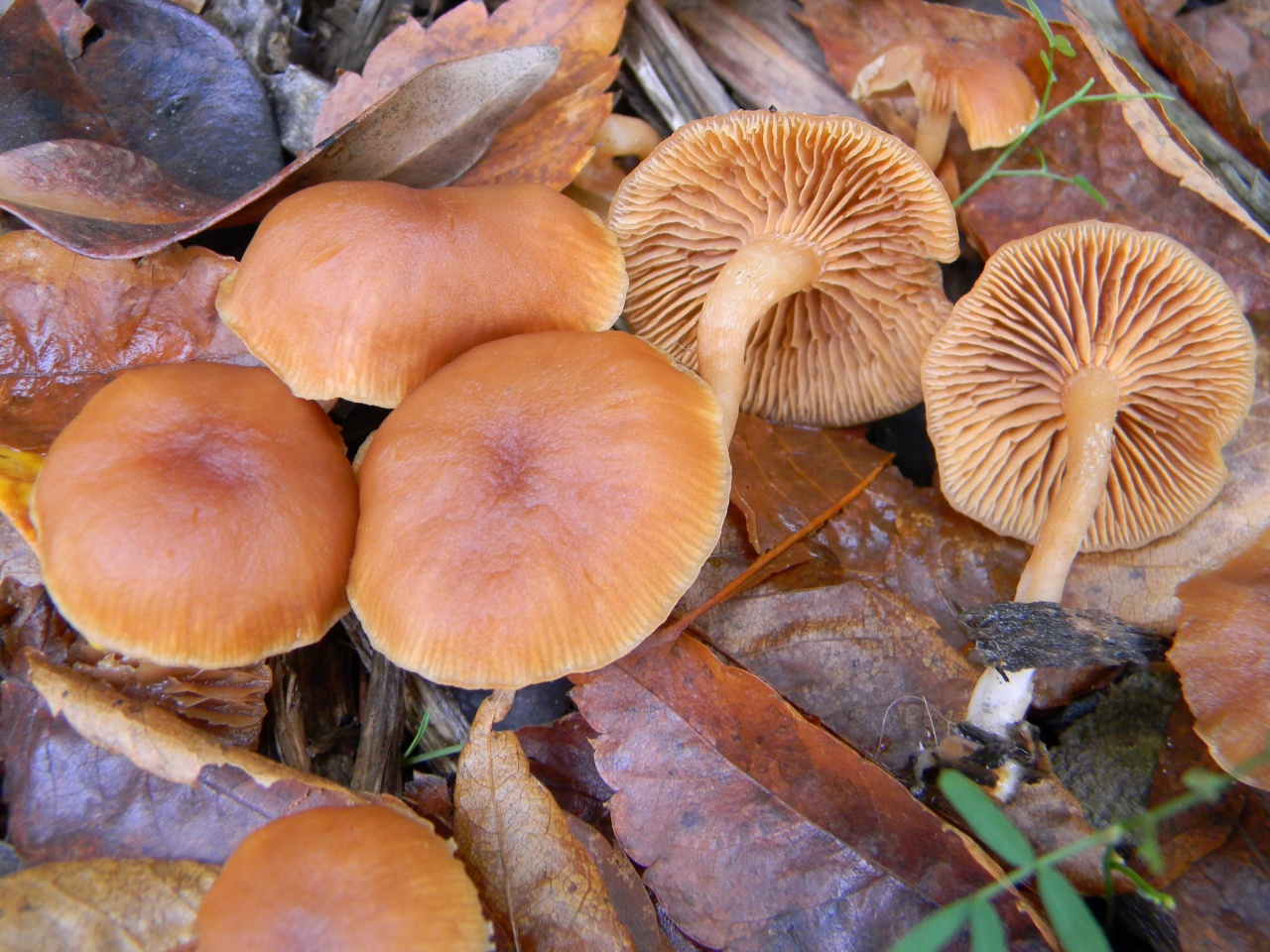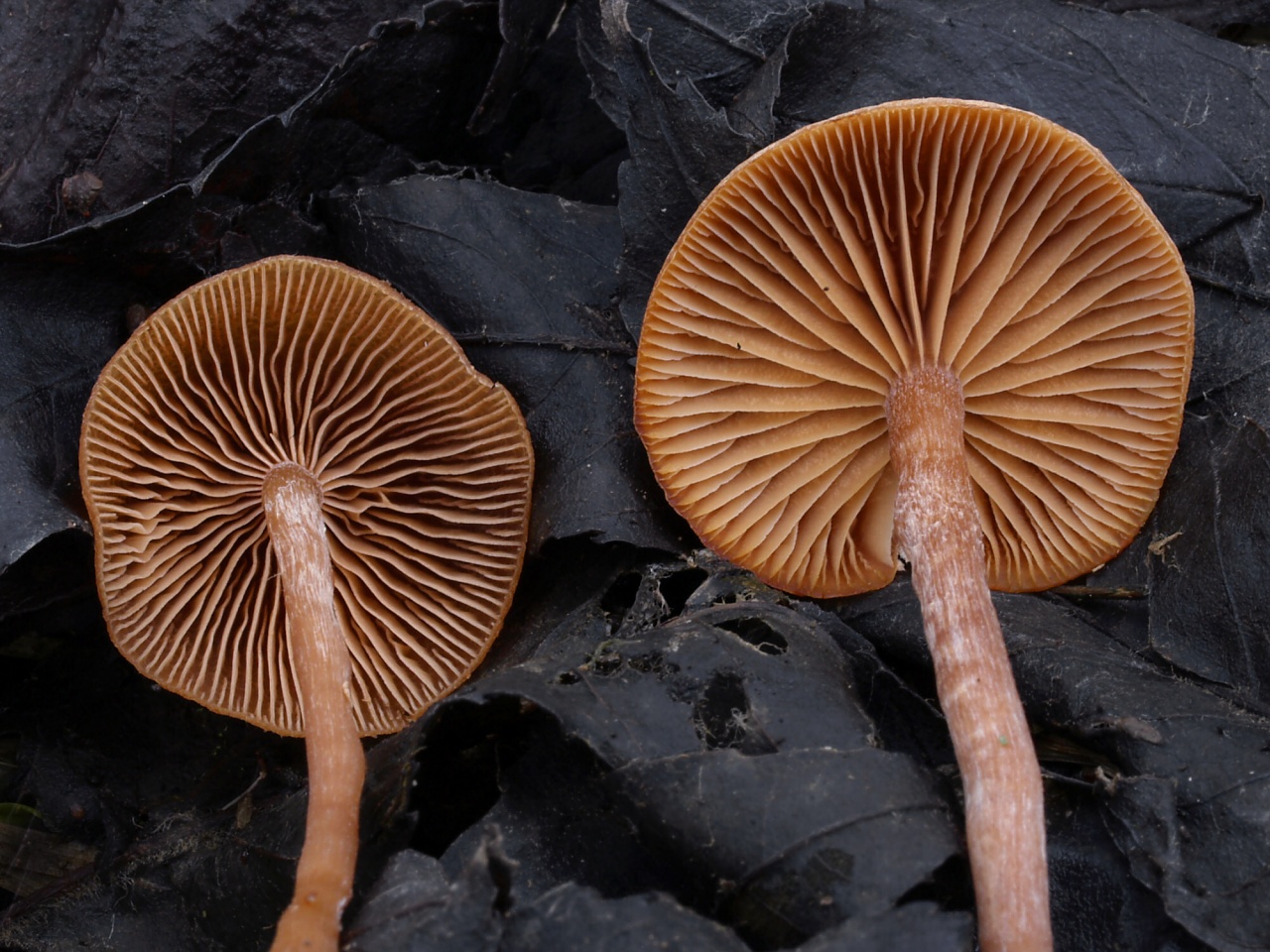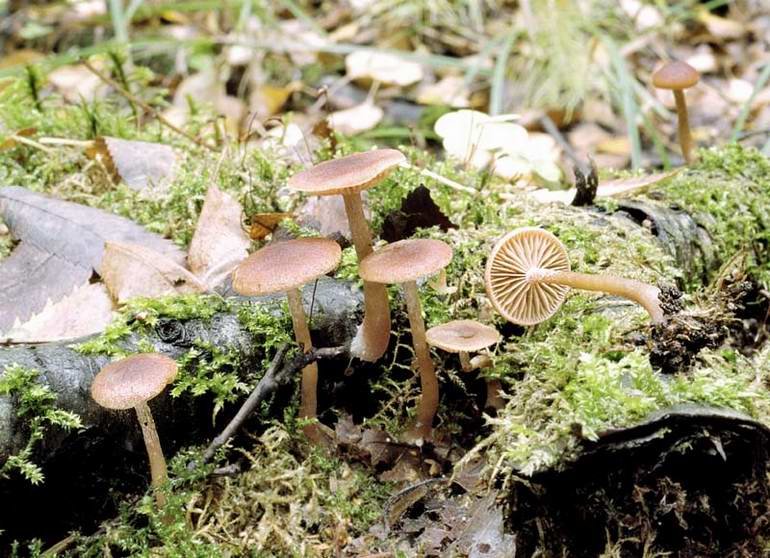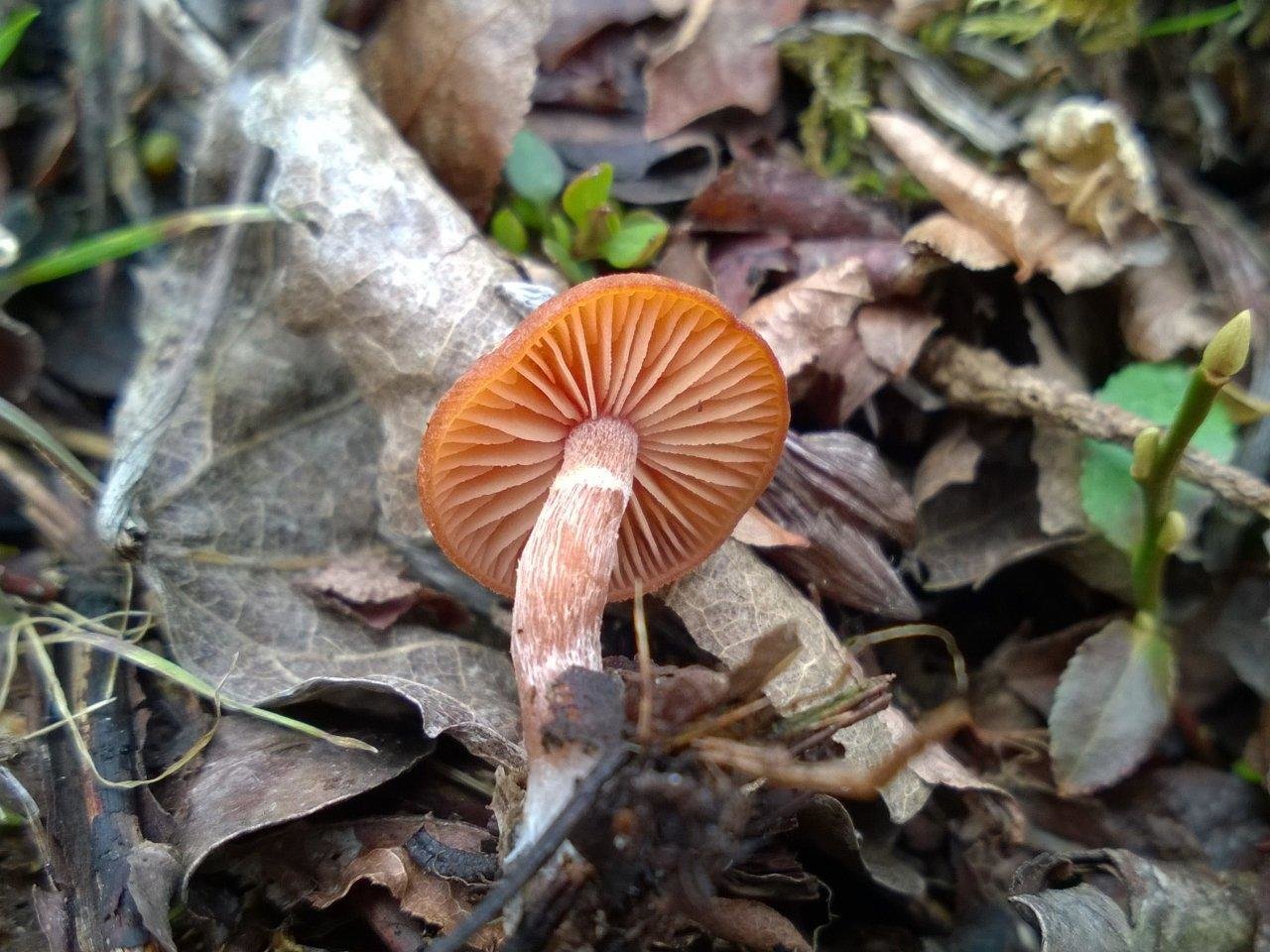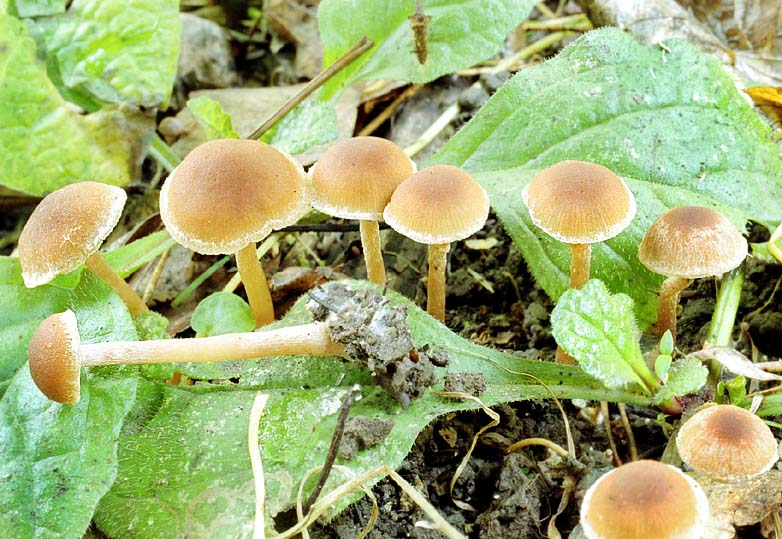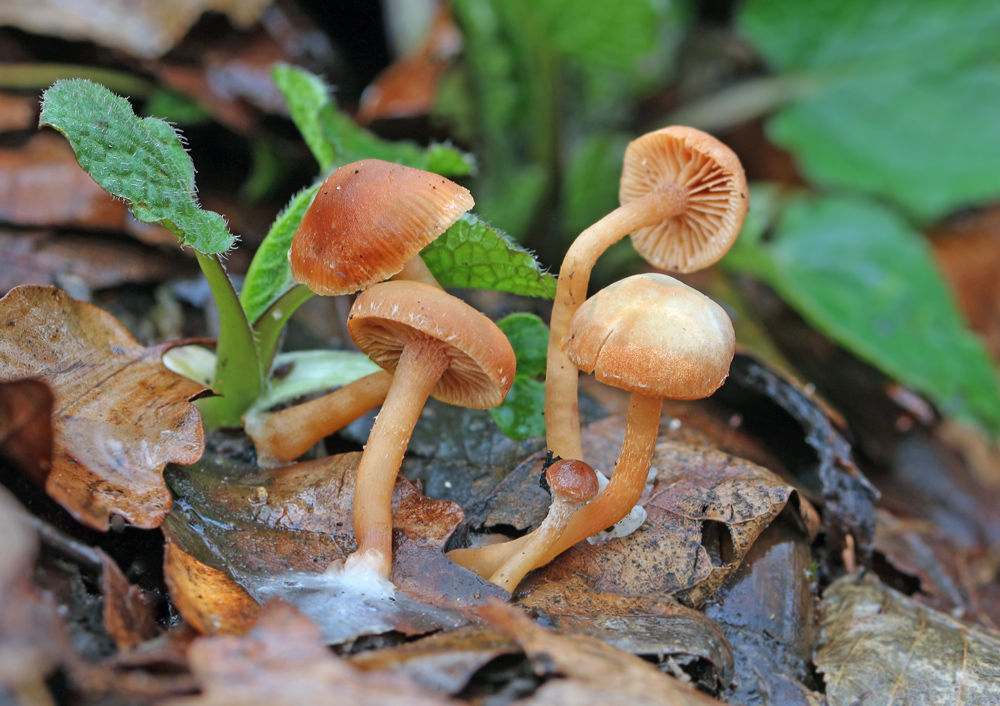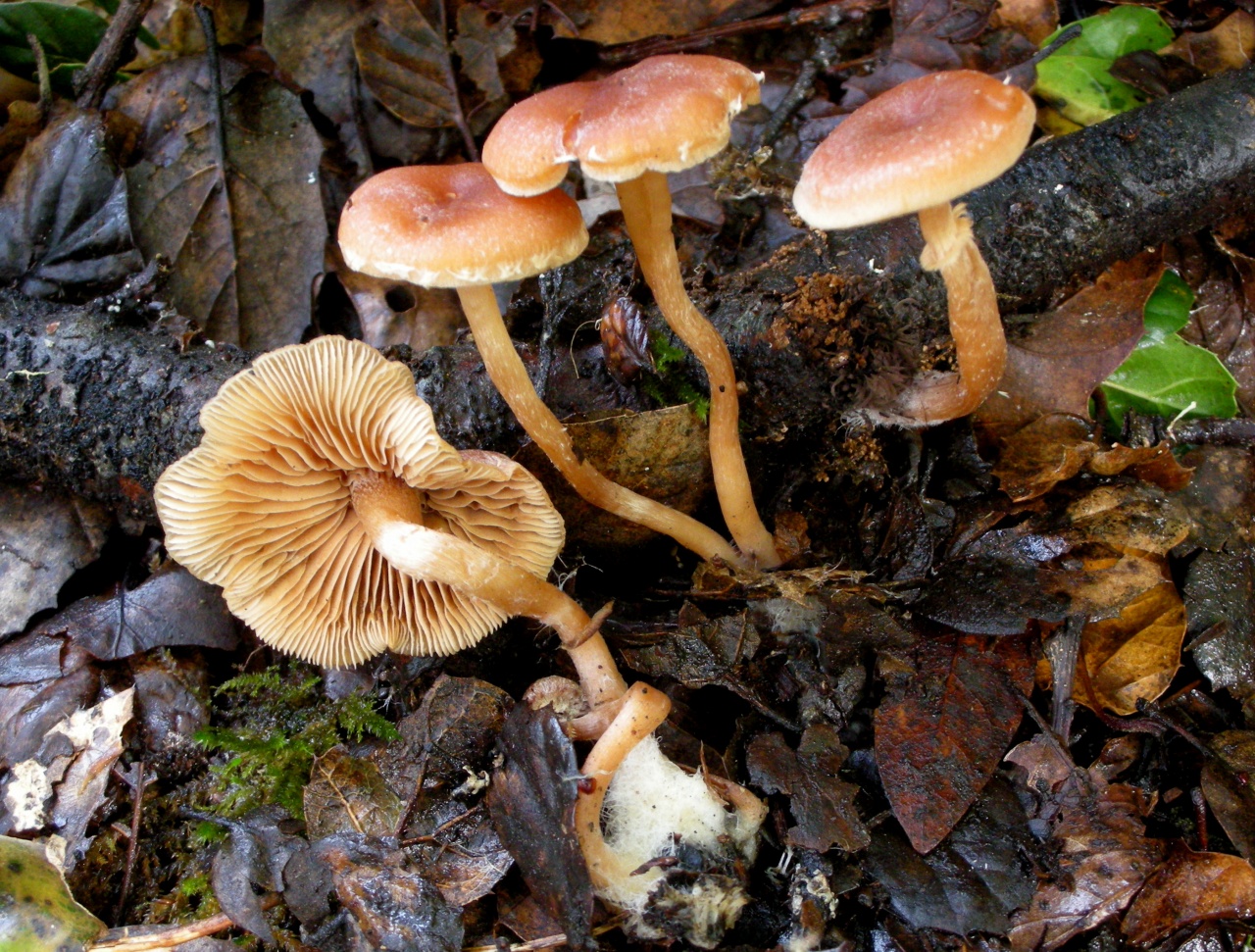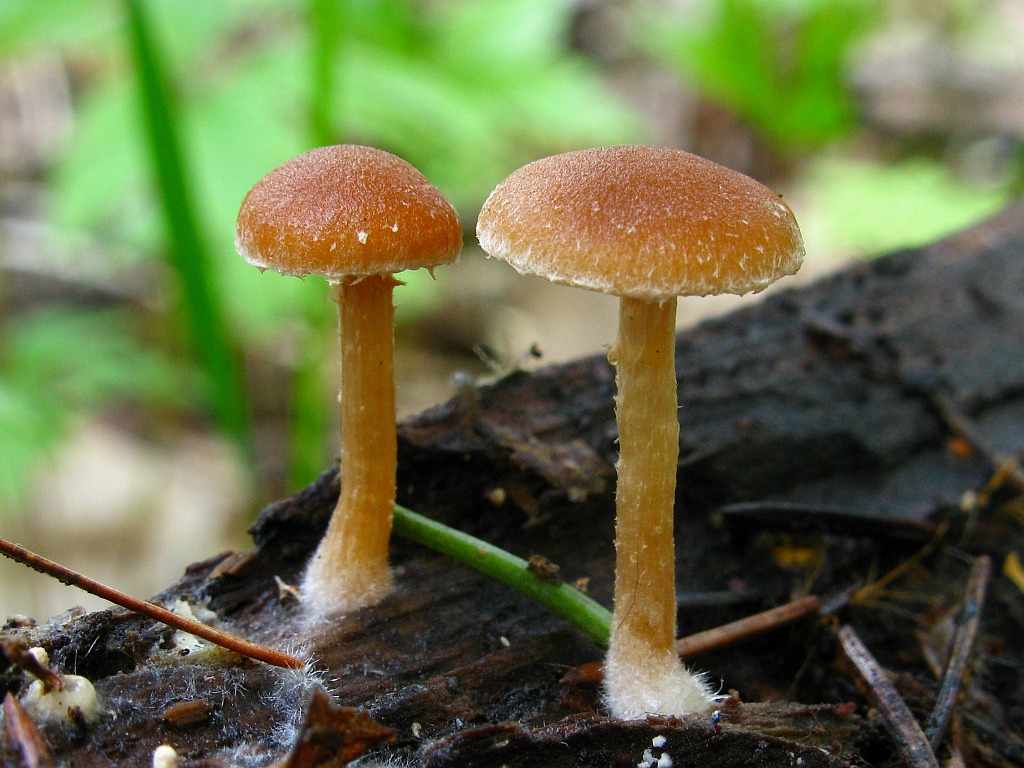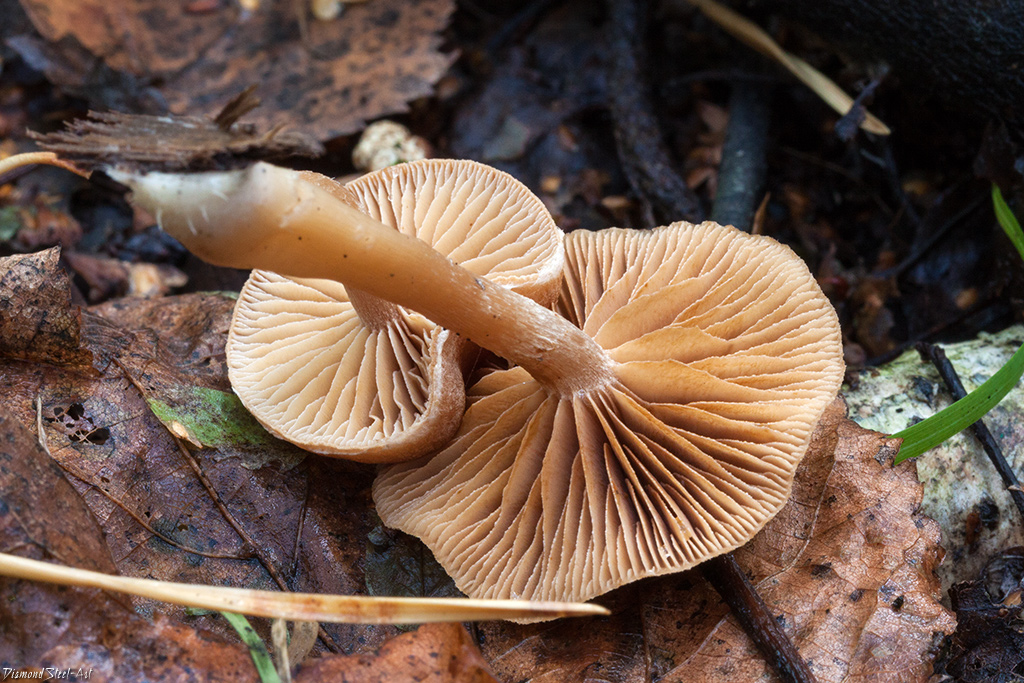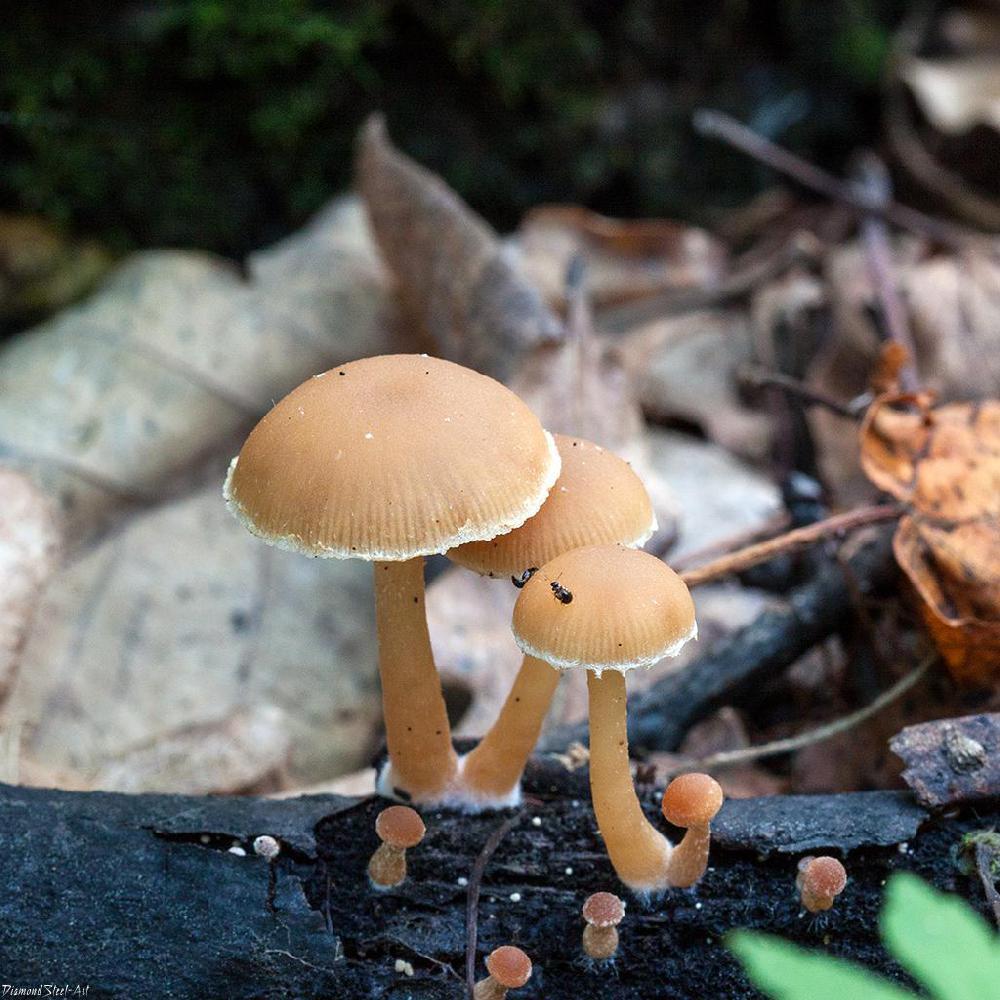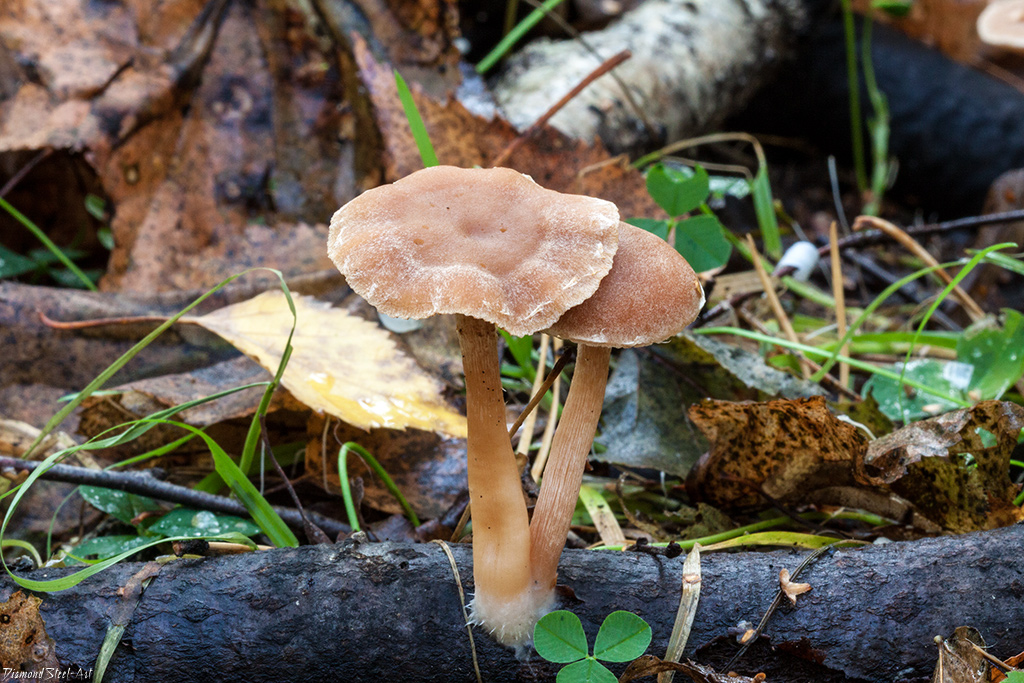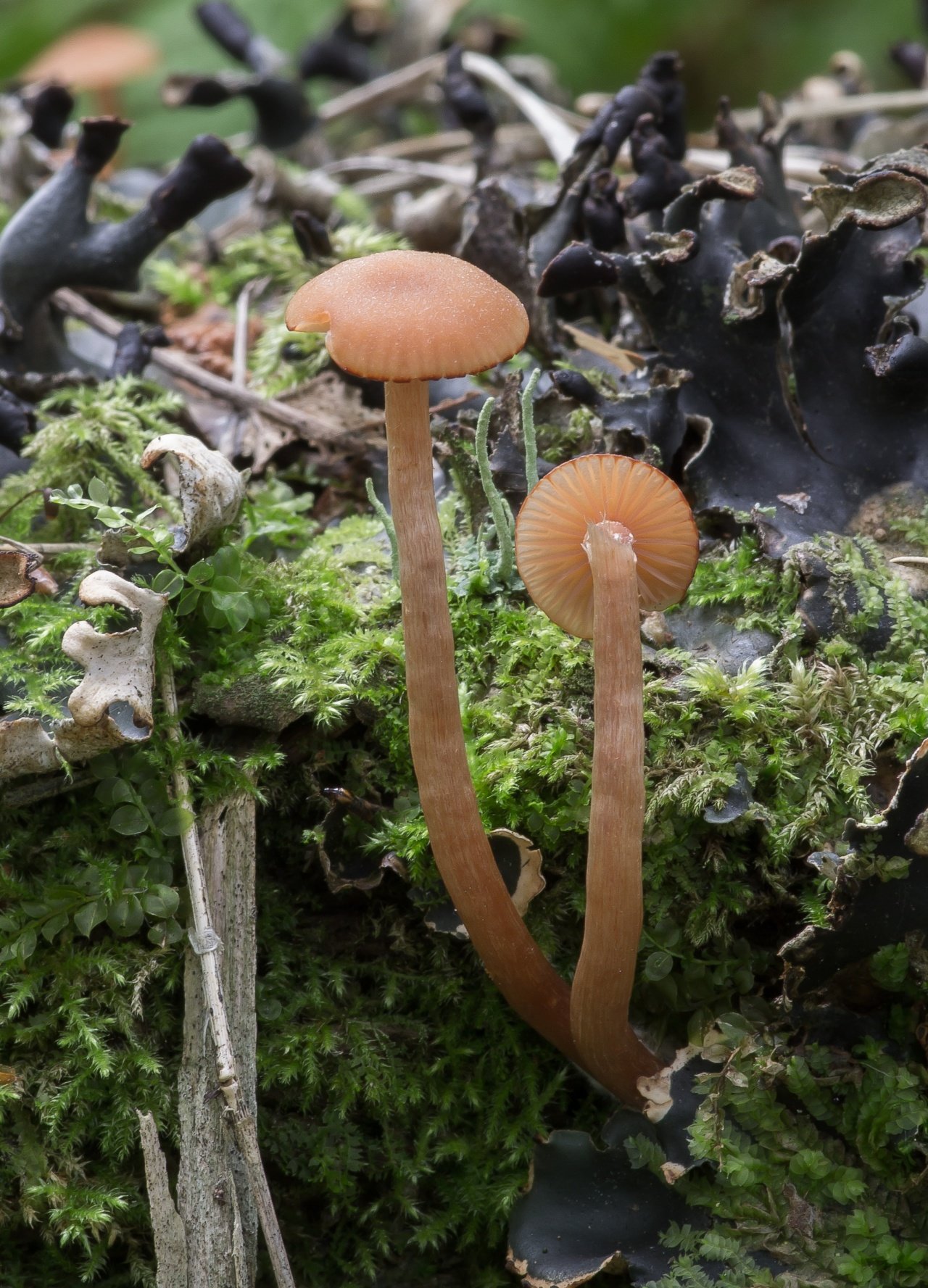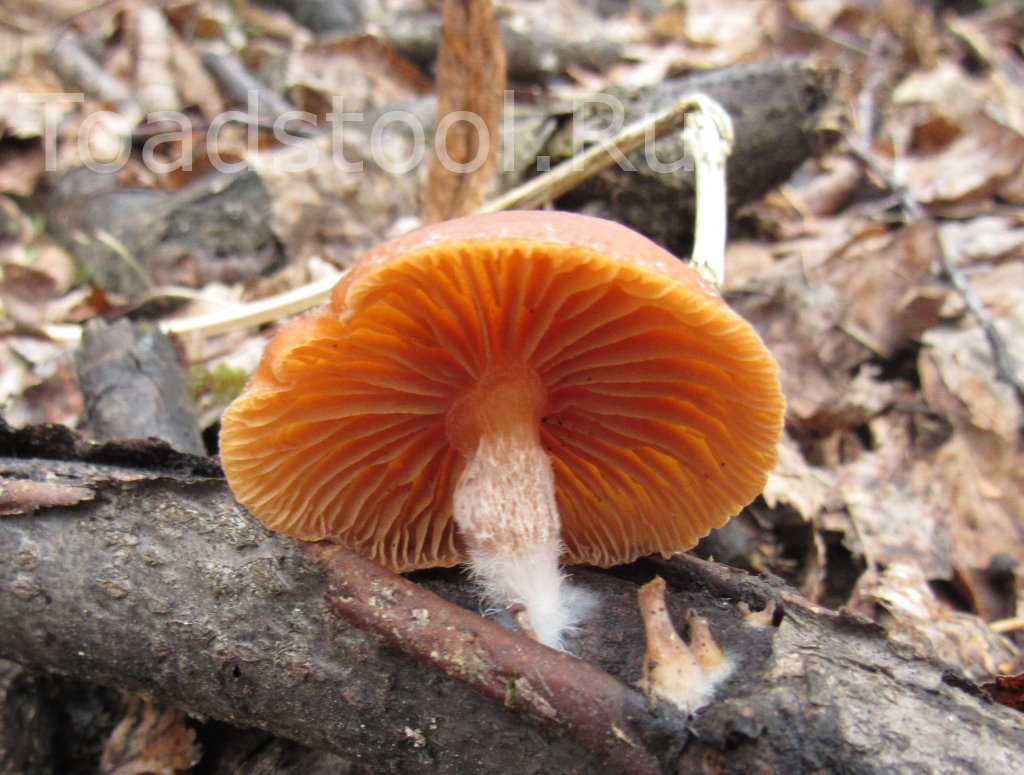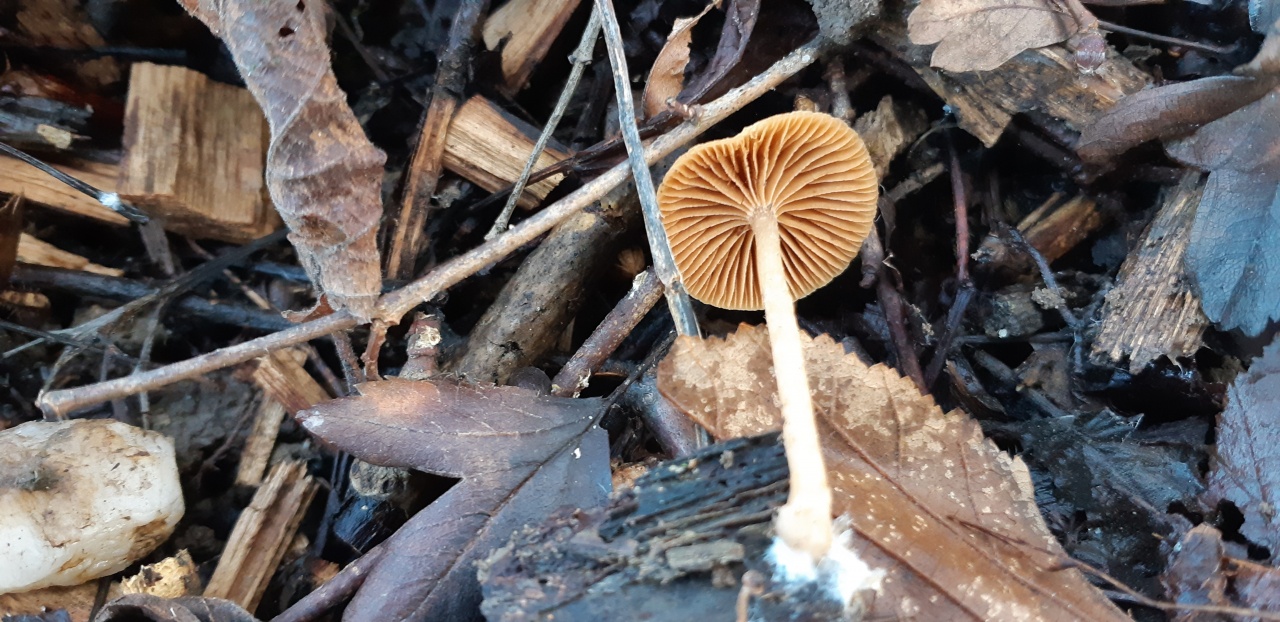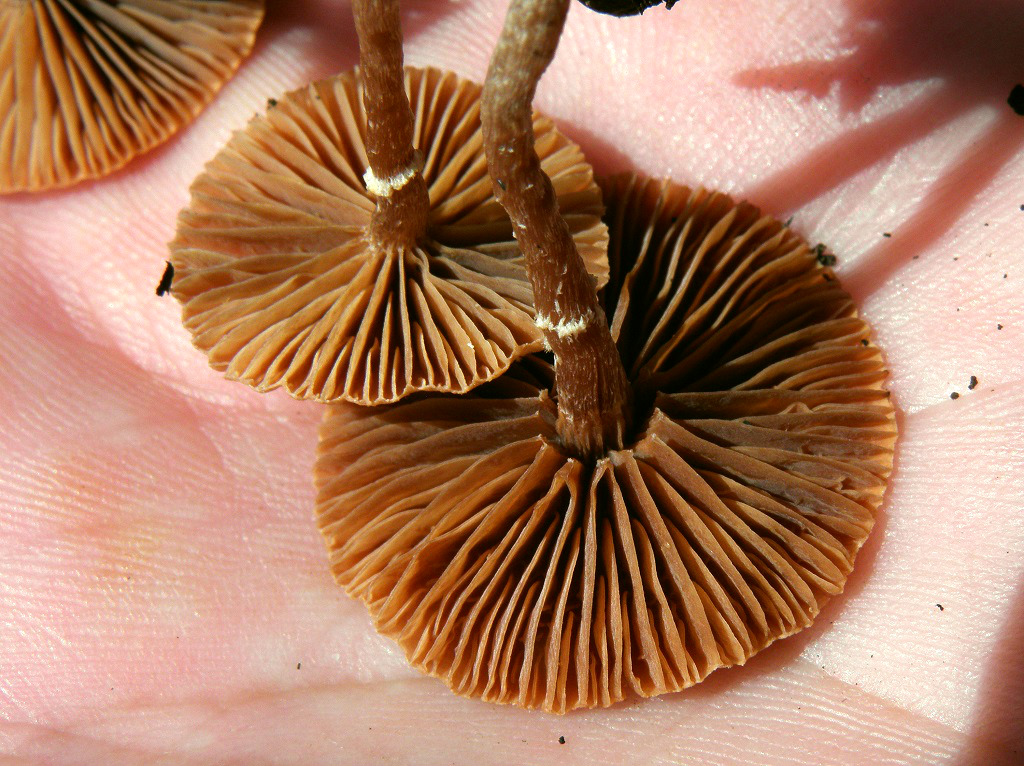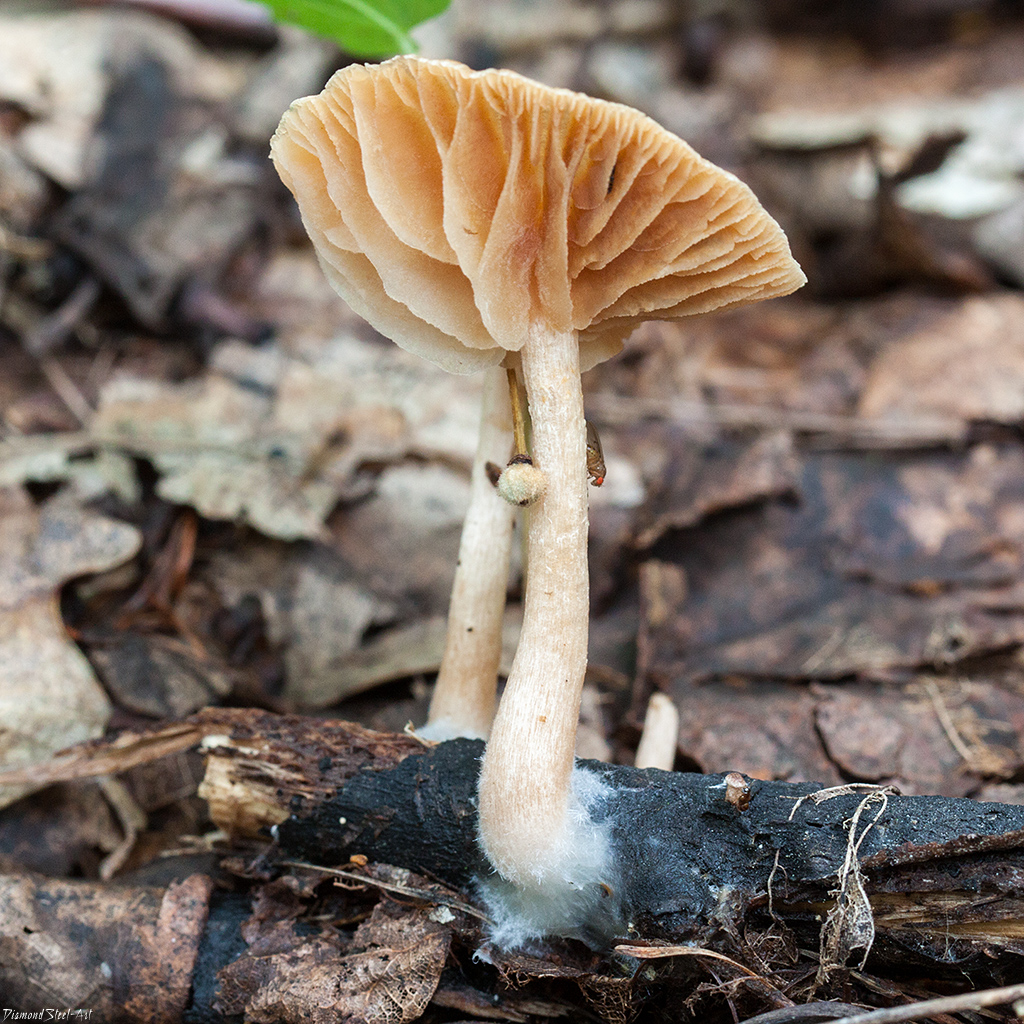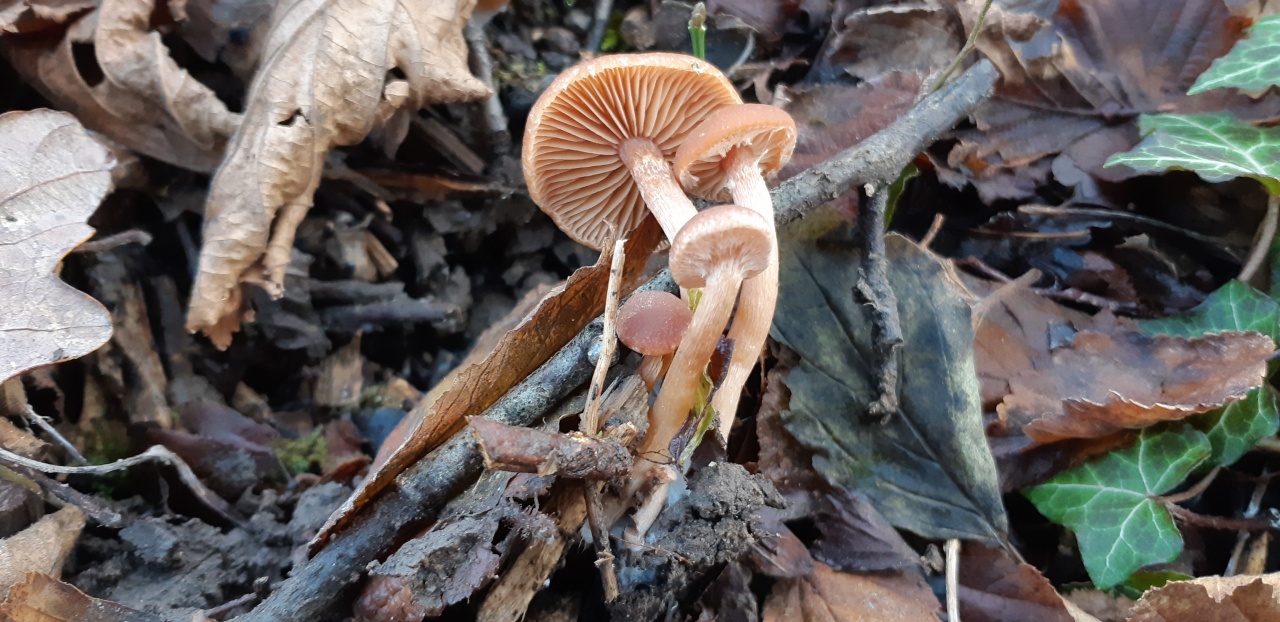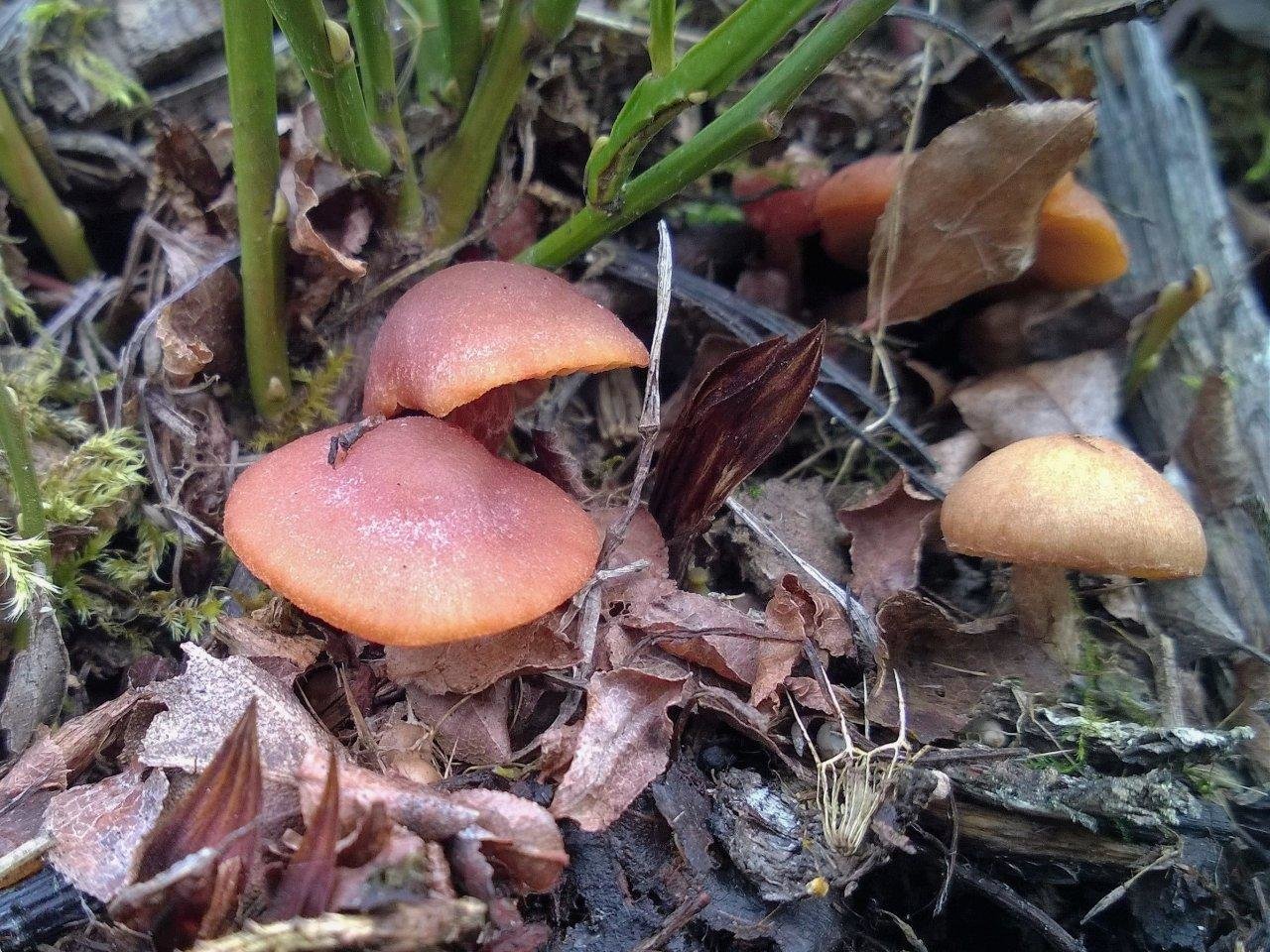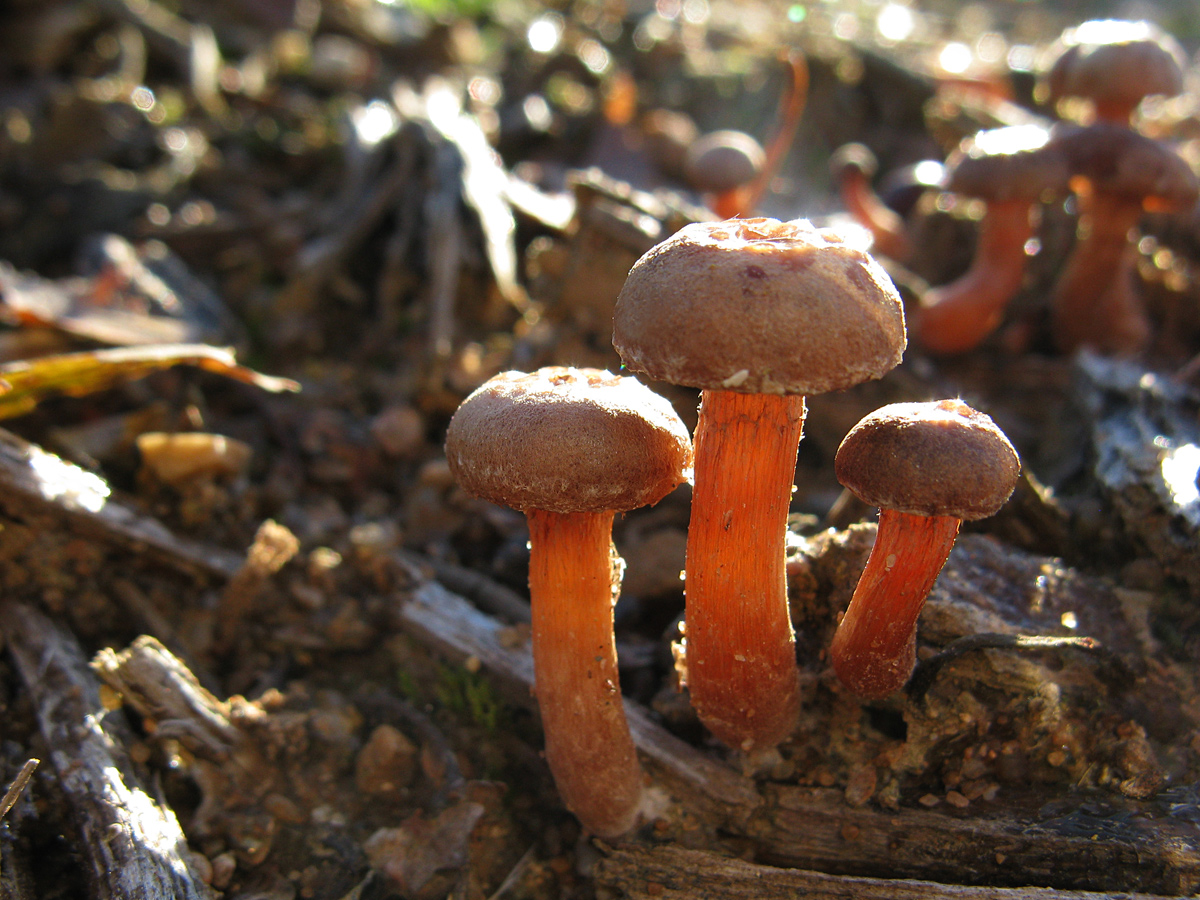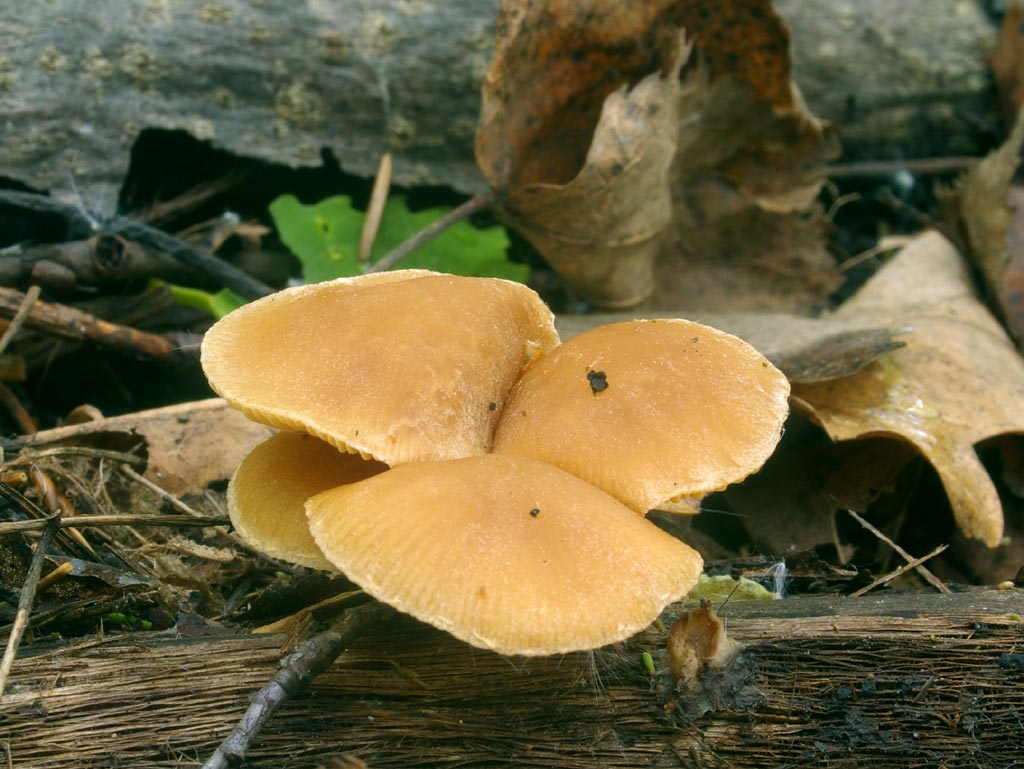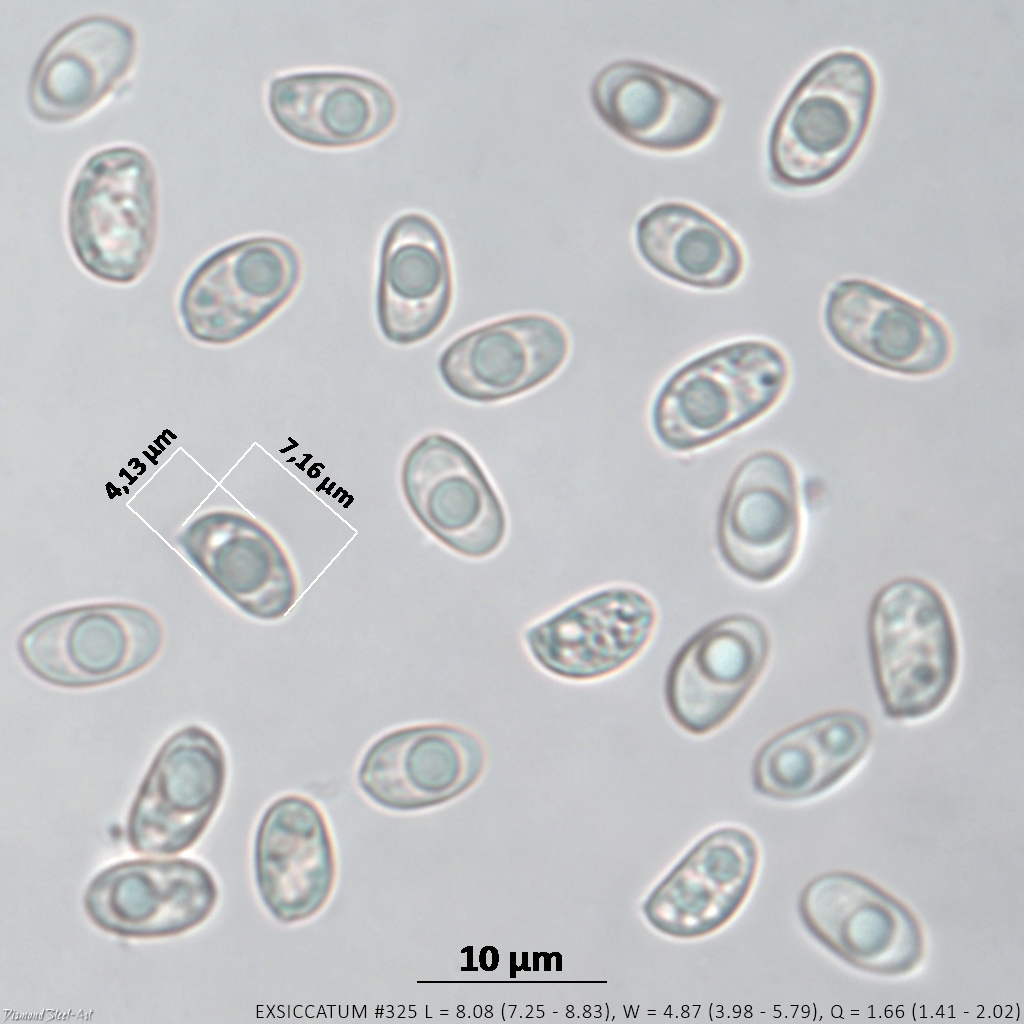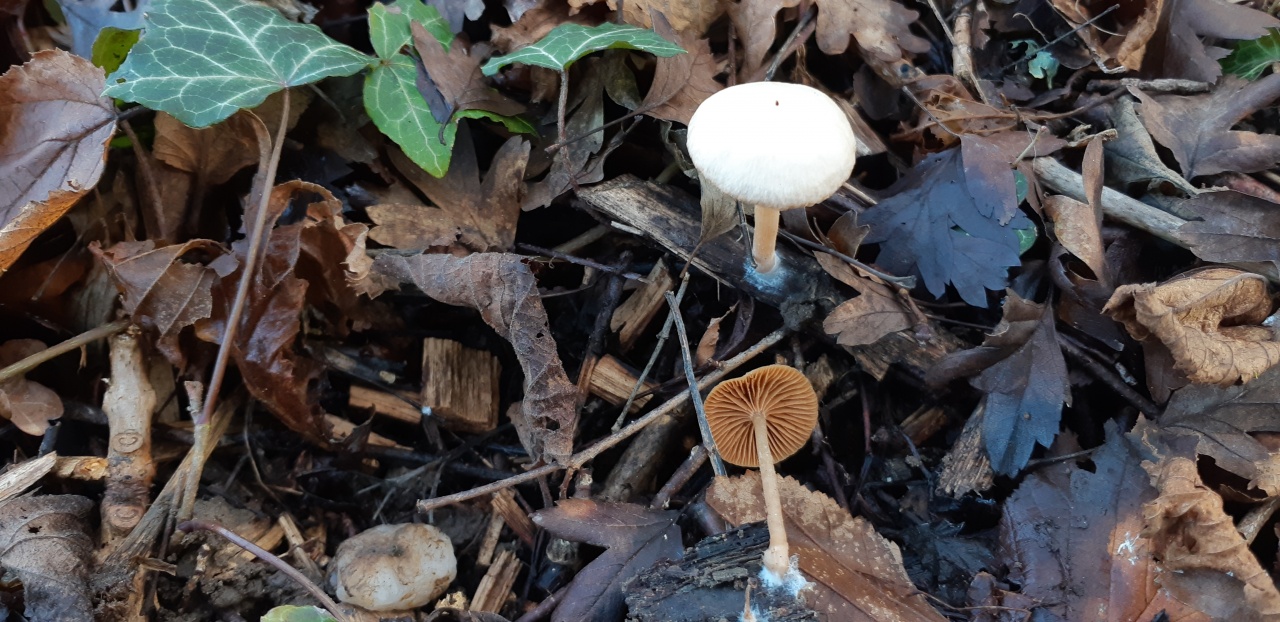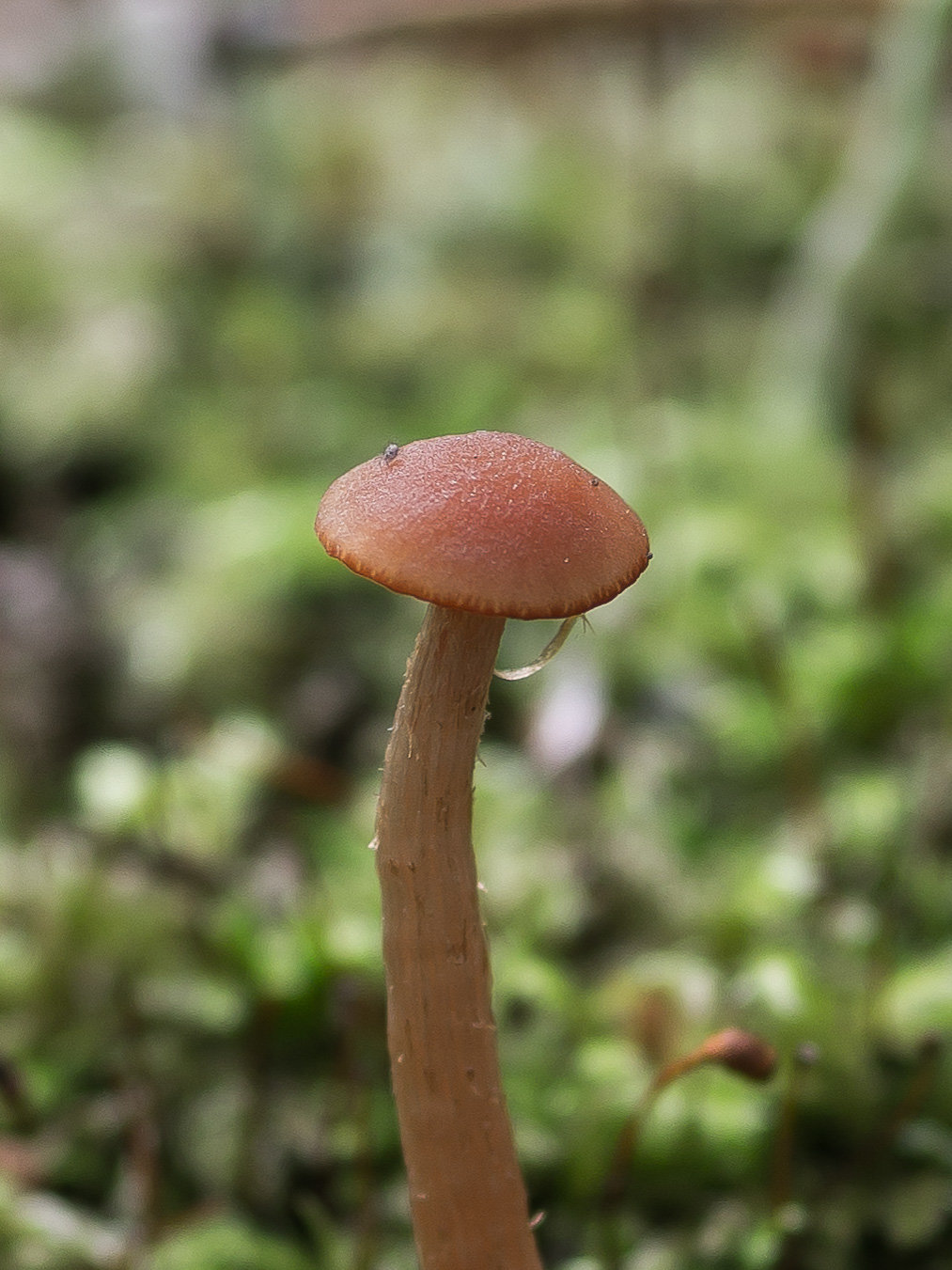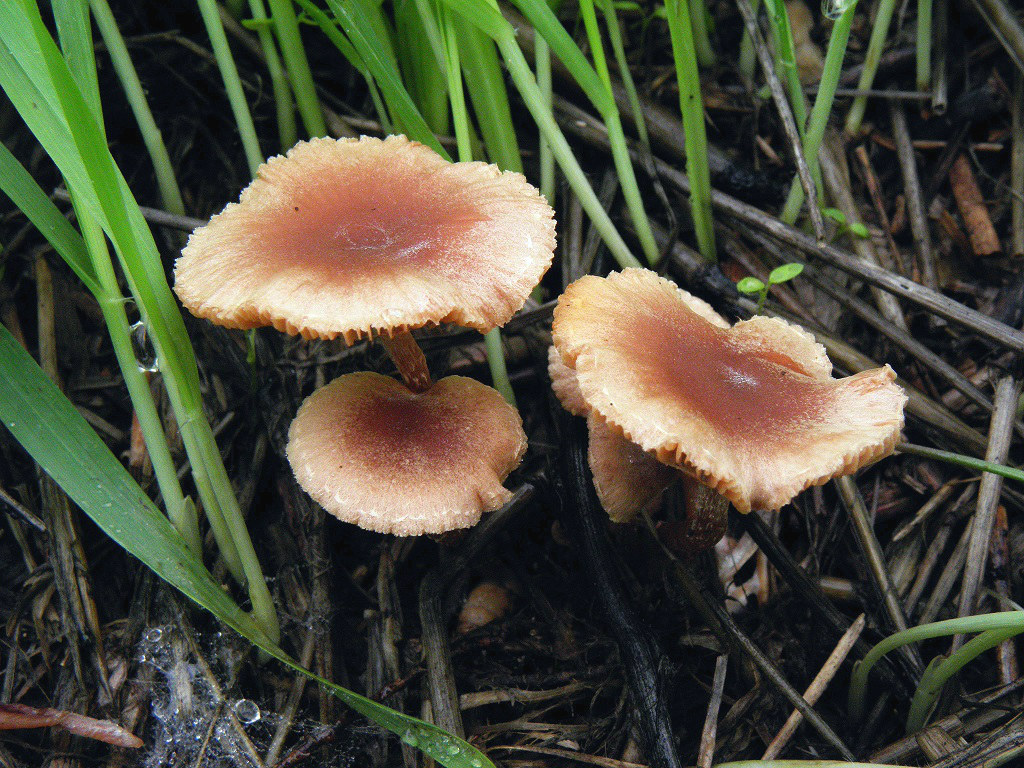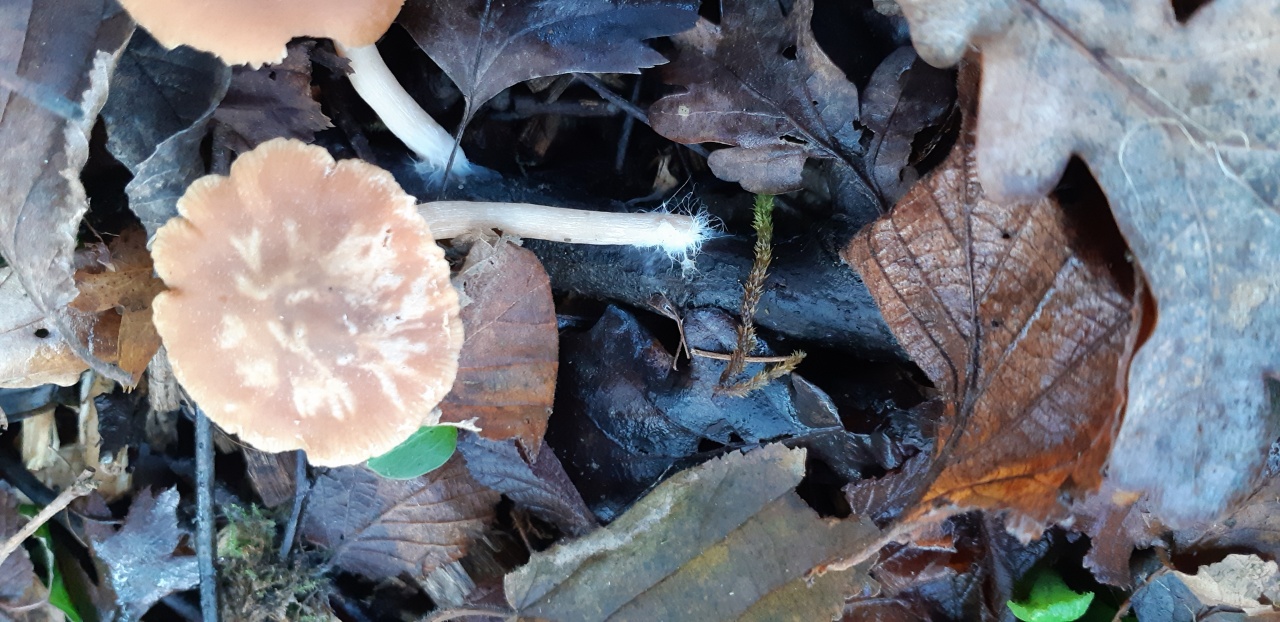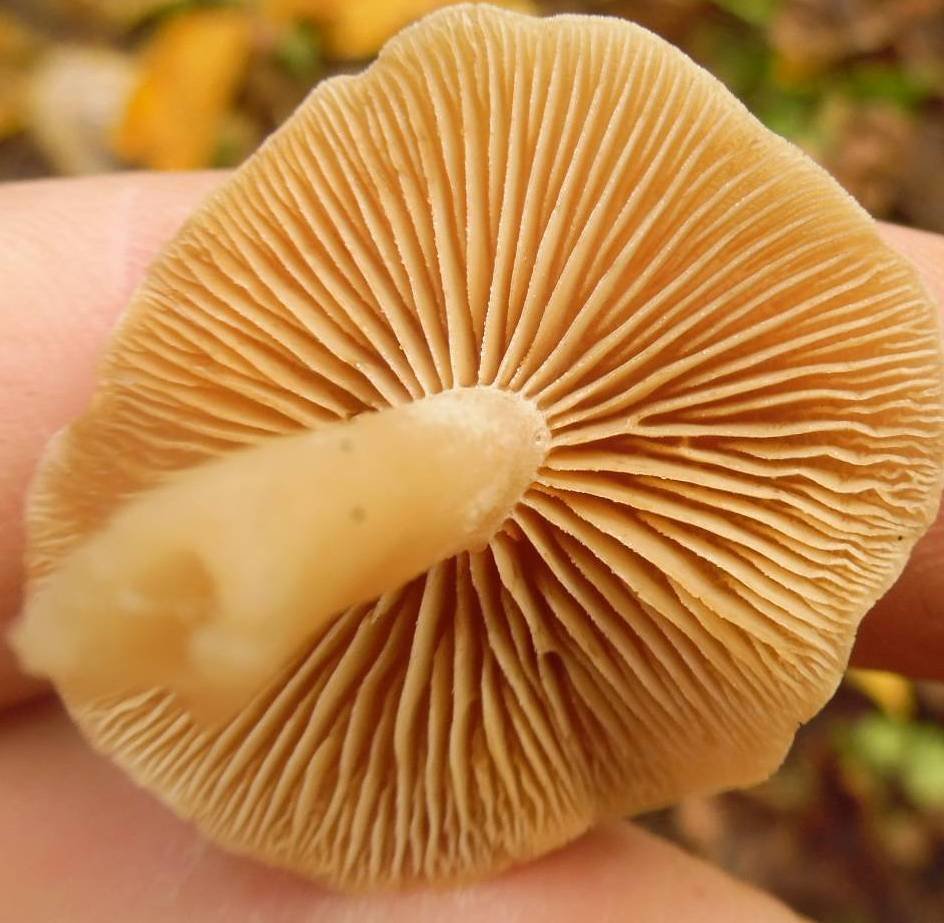Branched tubaria, Tubaria furfuracea
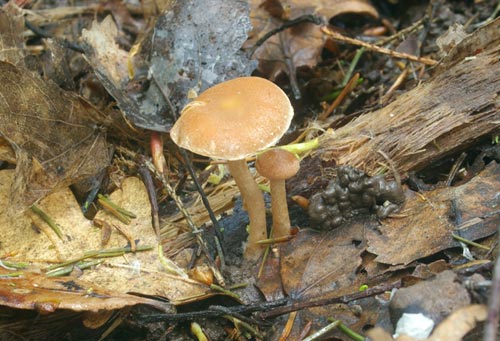
Hat: Small, 1-3 cm in diameter, convex to hemispherical in youth, with a tucked velvety edge, with age it straightens to almost spread, in older mushrooms it often takes on an irregular shape, with wavy edges; as the edges develop, they show characteristic lamellar scarring. The brownish or yellowish surface of the cap is covered with small white flakes, more often along the edges than in the center; the flakes, however, are easily washed off by rain, which makes the mushroom almost unrecognizable. The flesh of the cap is thin, pale yellow, watery, with a pungent odor or, according to other sources, odorless at all (perhaps the presence or absence of a smell is associated with frost).
Plates: Relatively sparse, thick, wide, poorly adherent, with well-visible veins, monochromatic, cap color or somewhat lighter.
Spore powder: Clay brown.
Stem: Relatively short (length 2-5 cm), 0.2-0.4 cm thick, hollow, fibrous, pubescent at the base, occasionally covered with small white flakes, like the cap. In young specimens, slight private bedspreads may be visible, which, however, are quickly washed off by rain and dew.
Distribution: Found everywhere during May, and also (according to literature data) in autumn. Grows on old woody remains, preferring deciduous species; can grow on land rich in woody humus. This tubarium, like mushrooms, practically does not form large clusters, and therefore often remains unnoticed by the wide masses of mushroom pickers.
Similar species: If we talk about the month of May, when most of the finds of Tubaria furfuracea are recorded, there are few similar fungi, and they all belong to the genus Tubaria. In particular, branched tubaria (especially mature, rains and frosts) is confused with a sprinkled tubaria, not very similar in a normal state, Tubaria conspersa, the caps of which are brick-red in color, and the plates are narrower and thinner. In autumn, an ordinary amateur has nothing to think about to distinguish the branched tubarium from the legions of similar gallerinas and other small brown mushrooms with adherent plates.
Edible: Unknown; tubaria is too similar to a gallery to make any experiments in this respect.
Author's notes: The branched tubaria could become a textbook mushroom. If, for example, some person uttered the banal idea that, they say, something at first glance completely nondescript upon close examination could turn out to be uniquely beautiful, and would cite as an example a macro photo of a would understand. But people prone to narcissism, for some reason, are rarely interested in mushrooms. And it is completely in vain: Tubaria furfuracea is really beautiful on close inspection, and from a distance it is not only inconspicuous, but generally invisible.
Biological description
Fruit bodies are cap-leg, regular. The cap is 1-4 (5) cm in diameter, hygrophane, convex, then opening to almost flat, sometimes even to depressed, with a turned up, then bent translucent edge, in young mushrooms covered with whitish remnants of the veil. The surface is finely flaked when dry, the color is red-brown, when dried brownish or pinkish-beige. The pulp is without a special taste and smell, yellowish-brown, watery.
The hymenophore is lamellar, adherent to the pedicle or slightly descending onto it. The plates are wide, relatively rare, yellowish, then yellowish-brown and rusty-brown. Spore mark of ocher-brown color.
Leg (1) 2-5 cm long and 0.2-0.4 cm thick, even, in young mushrooms with whitish remains of the veil, later sometimes remaining in the form of a ring, in old mushrooms hollow, often cracking longitudinally. The lower part of the peduncle is often with white pubescence. The color of the surface is pale brown, the same shade as the cap.
Spores are smooth, thin-walled, elliptical, 7-9 × 4.5-6 µm. Cheilocystids are uncolored, thin-walled, clavate.
The toxic properties of tubaria have not been studied. Most often listed as an inedible mushroom.
Similar views edit code
The branched tubaria is part of a complex of species with very blurred boundaries, which are often taken as synonyms. Tubaria praestans is a rather large species with a cap up to 7 cm in diameter and a stem up to 7 cm long, spores 7–7.5 × 5–6 µm. Tubaria hololeuca is distinguished by spores 5.5–6.5 × 4.5–5 µm. Tubaria romagnesiana and Tubaria hiemalis differ even less precisely.
Definitioner
- Basidia (Basidia)
-
Lat. Basidia. A specialized structure of sexual reproduction in fungi, inherent only in Basidiomycetes. Basidia are terminal (end) elements of hyphae of various shapes and sizes, on which spores develop exogenously (outside).
Basidia are diverse in structure and method of attachment to hyphae.
According to the position relative to the axis of the hypha, to which they are attached, three types of basidia are distinguished:
Apical basidia are formed from the terminal cell of the hypha and are located parallel to its axis.
Pleurobasidia are formed from lateral processes and are located perpendicular to the axis of the hypha, which continues to grow and can form new processes with basidia.
Subasidia are formed from a lateral process, turned perpendicular to the axis of the hypha, which, after the formation of one basidium, stops its growth.
Based on morphology:
Holobasidia - unicellular basidia, not divided by septa (see Fig. A, D.).
Phragmobasidia are divided by transverse or vertical septa, usually into four cells (see Fig. B, C).
By type of development:
Heterobasidia consists of two parts - hypobasidia and epibasidia developing from it, with or without partitions (see Fig. C, B) (see Fig. D).
Homobasidia is not divided into hypo- and epibasidia and in all cases is considered holobasidia (Fig. A).
Basidia is the place of karyogamy, meiosis and the formation of basidiospores. Homobasidia, as a rule, is not functionally divided, and meiosis follows karyogamy in it. However, basidia can be divided into probasidia - the site of karyogamy and metabasidia - the site of meiosis. Probasidium is often a dormant spore, for example in rust fungi. In such cases, probazidia grows with metabasidia, in which meiosis occurs and on which basidiospores are formed (see Fig. E).

See Karyogamy, Meiosis, Gifa.
- Pileipellis
-
Lat. Pileipellis, skin - differentiated surface layer of the cap of agaricoid basidiomycetes. The structure of the skin in most cases differs from the inner flesh of the cap and may have a different structure. The structural features of pileipellis are often used as diagnostic features in descriptions of fungi species.
According to their structure, they are divided into four main types: cutis, trichoderma, hymeniderma and epithelium.
See Agaricoid fungi, Basidiomycete, Cutis, Trichoderma, Gimeniderm, Epithelium.
- Trichoderma
-
The type of cap skin, usually consists of straight, septate elements located more or less perpendicular to the surface and laid both at the same and at different levels; the ends of the hyphae can be morphologically modified and represent dermatocystids. The surface of the cap is velvety to almost felt.
Lat. Trichoderm.
Trichoderma, in turn, is subdivided into intertwined trichoderma and irregular trichoderma.
Intertwined trichoderm (Intricate trichoderm) - trichoderm, consisting of intertwined hyphae, located not parallel to each other and forming a tomentose pubescence.
Irregular trichoderm - Trichoderma, consisting of irregularly branching hyphae.
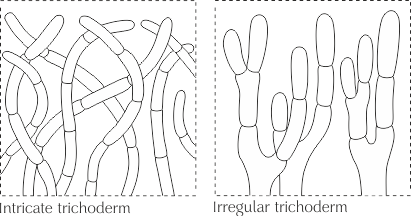
See Dermatotsistida, Hypha, Septa.
Taxonomy
Tubaria branched was first described by Jacob Christian Schaeffer in 1774 in a combined genus of lamellar mushrooms called Agaricus pulverulentus... In 1801 it was renamed by K. Kh. Person in Agaricus furfuraceus... It was this name that was adopted by E.M. Fries in 1821 in Systema mycologicum... In 1876, Claude-Casimir Gillet separated into a separate genus Tubaria.
Synonyms edit code
- Agaricus crenulatus Batsch, 1783, nom. superfl.
- Agaricus furfuraceus Pers., 1801: Fr., 1821basionym
- Agaricus furfuraceus var. heterostichus Fr., 1818
- Agaricus furfuraceus var. sobrius Fr., 1818
- Agaricus furfuraceus var. viscosus Lasch, 1828
- Agaricus heterostichus (Fr.) Fr., 1821
- Agaricus pulverulentus Schaeff., 1774
- Agaricus sobrius (Fr.) Fr., 1874
- Hylophila pellucida var. furfuracea (Pers.) Quél., 1886
- Hylophila sobria (Fr.) Quél., 1886
- Naucoria furfuracea (Pers.) P. Kumm., 1871
- Naucoria sobria (Fr.) P. Kumm., 1871
- Psilocybe heterosticha (Fr.) Singer, 1969
- Tubaria anthracophila P. Karst., 1881
- Tubaria crenulata (Batsch) Murrill, 1917, nom. superfl.
- Tubaria furfuracea subsp. heterosticha (Fr.) Sacc., 1889
- Tubaria furfuracea var. anthracophila (P. Karst.) Singer, 1969
- Tubaria furfuracea var. crenulata (Batsch) Elisei, 1938
- Tubaria furfuracea var. hiemalis (Romagn.ex Bon) Volders, 2002
- Tubaria furfuracea var. novembris Singer, 1969
- Tubaria heterosticha (Fr.) Sacc., 1887
- Tubaria hiemalis Romagn. ex Bon, 1973 - Wintering Tubaria
- Tubaria hiemalis var. major Bon & Trimbach, 1973
- Tubaria major (Bon & Trimbach) P. Roux & P.A. Moreau, 2008
- Tubaria romagnesiana Arnolds, 1982
Evaluation of the edibility of branched tubaria
Tubaria is not eaten in food, it is not edible.
Other fungi of the family
Crepidotus is a beautiful scaly - an inedible mushroom. The fruit body of this fungus is sessile, without a stem. The cap is strongly convex at first, and then becomes reniform or shell-shaped. Its diameter is 1.5-6 centimeters. The surface of the cap is cream or white with ocher or brown scales. The pulp is thick, with a sweetish taste, creamy color.
Krepidota beautifully scaly settle on the remains of deciduous, less often coniferous wood. These fungi cause the development of white rot. They are found on poplars, ash, willows, pines from July to September.

Torn fiber is a deadly poisonous mushroom. At a young age, her cap is broadly bell-shaped, but then it opens, only a small tubercle remains in the center. In the center, the cap is brown, and at the edges it is lighter. Its diameter does not exceed 5 centimeters.
The pulp tastes sweet at first, and then begins to taste bitter. The leg is straight, dense, 4-8 centimeters long. The color of the leg is reddish or brown.
Broken fibers can be found in damp areas. These mushrooms grow in mountains, forests, along the edges of ditches and roads. They meet in small groups or singly.


